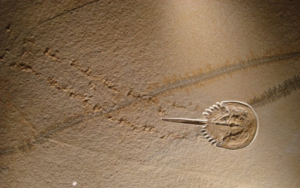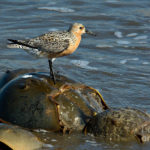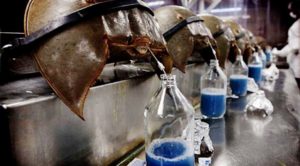What Can We Learn From the Blood of Horseshoe Crabs?
by Taylor McConnell, Nauticus Education Specialist
Horseshoe Crabs are known as a living fossil, this is because they have existed for over 450 million years. They have survived many mass extinctions, numerous shifts in the plate tectonics, ice ages, the rise and fall of the dinosaurs and the start of the human race. But the current question is, are horseshoe crabs here to stay?

Horseshoe Crabs have a crucial role in their ecosystem, their eggs support many migratory bird species and their larvae supports many fish species. However, like many shoreline ecosystems, their habitat is being destroyed through pollution and human development.


But the Horseshoe Crabs have a secret. Their secret is in their blue blood and it is saving lives. Every vaccination, every Food and Drug Administration (FDA)-approved prescription drug, many intravenous (IV) medications and injectable medications are tested for harmful bacteria, by Horseshoe Crab blood. The harmful bacteria that the Horseshoe Crab blood can detect is the same bacteria that causes fever, shock, and many other conditions in humans.
Horseshoe Crabs (Limulus polyphemus) have a unique way to combat these harmful bacteria. When the bacteria enters their body, their blood cells surround the harmful bacteria and clot to neutralize it. So, in the 1970s scientist started using Horseshoe Crab blood to help the biomedical field test for the harmful bacteria, and today it is known as a LAL test. LAL means:

Horseshoe Crab blood is collected by harvesting the animal and draining up to 33% of their blood. Each year about 500,000 Horseshoe Crabs are collected for this process. Many of these animals are then marked, so they are not collect a second time in a season, and released back into the wild. The current mortality rate is not well studied and varies depending on the source. Conservationist groups estimate about 30% whereas the fisheries industry estimates with 5% to 15%. While the exact mortality rate is currently unknown, at least 150,000 Horseshoe Crabs end up being sold to the bait industry to be used to catch American eel and conch.

What does this all mean for the Horseshoe Crabs and their future? Scientist are working on two methods to help the biomedical field with their need, while trying to reduce the need to harvest Horseshoe Crabs from the wild.
One method is captive breeding. Carmela Cuomo from University of New Haven in Connecticut has been doing research since early 2000 to figure out how scientist can get Horseshoe Crab to breed in captivity. This research is taking many years and she had a breakthrough in 2008. She and her team discovered that the Horseshoe Crabs want to lay their eggs on the beaches where they were hatched. So to replicate the beaches the team collected sediment from the beaches where they collected the Horseshoe Crabs from and they started to see eggs being produced. While captive Horseshoe Crab breeding has not become a large scale operation it is a potential strategy to use to reduce the number of wild caught Horseshoe Crabs.
Method two is to use a synthetic alternative (an equivalent man-made chemical) developed in the lab. There are many research groups working to create synthetics alternatives and the current projects are estimating a reduction in bleeding wild-caught Horseshoe Crabs by about 90%. Many of these research groups have developed the synthetic alternative and have tested the effectiveness to make sure it is comparable with Horseshoe Crab blood. However, now they have to communicate with the biomedical field and show that their synthetic alternative does match up with the ability of the blood of Horseshoe Crabs.
The fate of the Horseshoe Crab is still unknown and there are many challenges that the Horseshoe Crab still has to overcome. Next time you see a Horseshoe Crab remember to thank them, for every vaccination, for every FDA-approved prescription drug, for every medication received through an IV and for every other medical equipment and devices that touched human blood.
Citations
“Inside the American Museum of Natural History: Museum Secrets (Series 2).” Films Media Group, 2012, digital.films.com/PortalPlaylists.aspx?wID=103059&xtid=57622. Accessed 25 Mar. 2020.
Maloney, Tom, Ryan Phelan, and Naira Simmons. “Saving the Horseshoe Crab: A Synthetic Alternative to Horseshoe Crab Blood for Endotoxin Detection.” PLoS Biology 16.10 (2018): E2006607. Web.
National Park Service. “The Natural History of Horseshoe Crabs.” Fire Island; National Seashore, New York (May 31, 2018). Web.